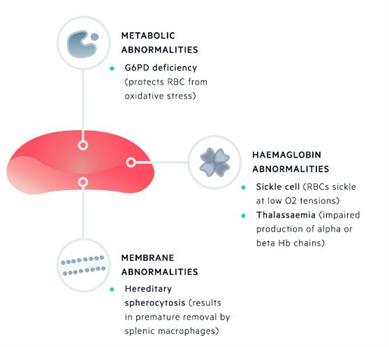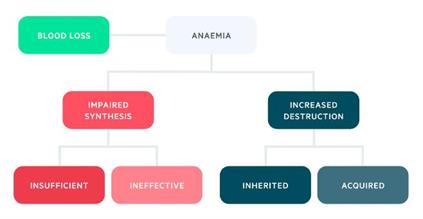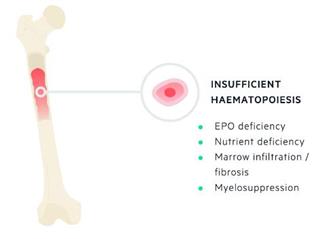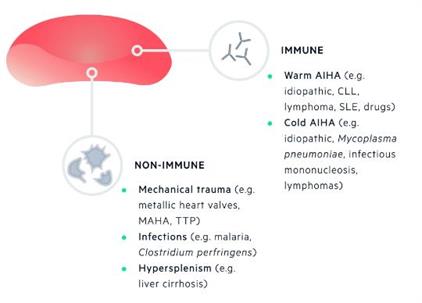





Anaemia Mechanistic classification

Insufficient production of RBCs occurs
Normal erythropoietic process
is reduced or inhibited.
This may be due to 4 Senarios:
1. A lack of required nutrients (e.g. iron),
2. Reduced hormonal influence (e.g. low EPO, hypothyroidism),
3. Bone marrow infiltration. Fibrosis
4. Bone marrow suppression

Ineffective production of RBCs
Abnormal erythropoiesis.
In the bone marrow,
There is a marked increase in the erythroid cell line,
but erythroid precursors
do not mature properly
and subsequently undergo apoptosis.
Conditions that lead to ineffective erythropoiesis include:
- Megaloblastic anaemias (e.g. folate and B12 deficiency),
- Thalassaemias,
- Myelodysplastic syndromes
- Sideroblastic anaemia.
Inherited haemolytic anaemias
can be further classified based on
the site of inherited defect:
Membrane abnormalities
(e.g. hereditary spherocytosis)
Metabolic deficiencies
(e.g. G6PD deficiency)
Haemoglobin abnormalities
(e.g.
- alpha-thalassaemia,
- beta-thalassaemia,
- sickle cell disease)

Acquired haemolytic anaemias
can be divided into immune and non-immune:Immune
(e.g. warm and cold
autoimmune haemolytic anaemia)
Non-immune
(e.g.
- mechanical trauma,
- hypersplenism,
- infections,
- drugs)

Blood loss
Blood loss is a common cause of anaemia,
it may be obvious (e.g. trauma, haematemesis)
or occult (e.g. gastrointestinal malignancy).
Erythrocytes form a major store of iron within the body.
This means a loss of erythrocytes could lead to the development iron deficiency anaemia (IDA).
Consequently, IDA commonly reflects blood loss from an unidentified source that requires further investigation.
Two common sources of blood loss include
- menstruation in young females
- and gastrointestinal bleeding in older populations.
Impaired synthesis
Anaemia will develop if the rate of RBC production
does not adequately meet the bodies requirements.
A decrease in RBC production
can occur due to two main mechanisms:
Insufficient production of RBCs OR Ineffective production of RBCs


Increased destruction
Haemolysis refers to the destruction of red blood cells,
which is broadly defined as
a reduction in the lifespan of RBCs below 100 days
(normal 110-120 days).
If RBC production in the bone marrow cannot keep pace
with the level of haemolysis,
then haemolytic anaemia with ensue.
The haemolytic anaemias can be divided into
inherited and acquired.






